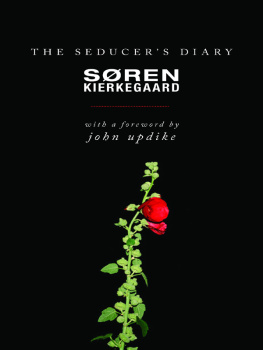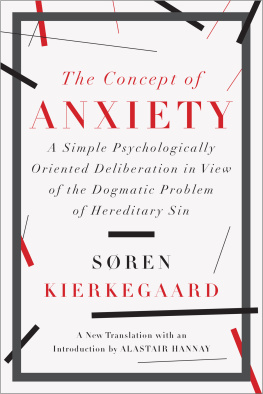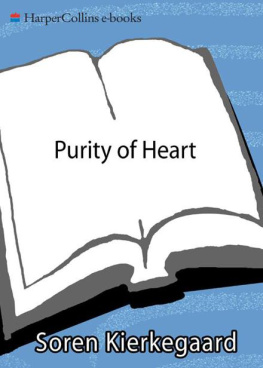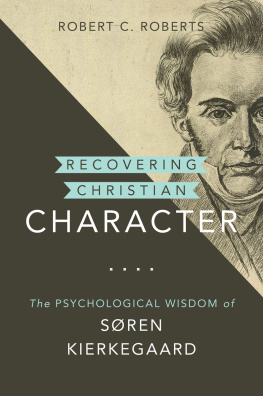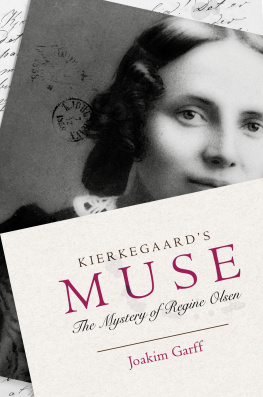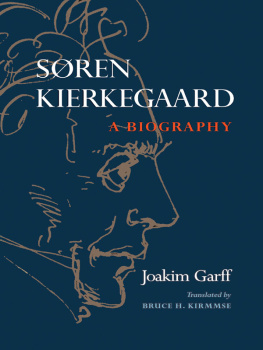
THE SEDUCERS DIARY
Sren Kierkegaard
PRINCETON UNIVERSITY PRESS
PRINCETON AND OXFORD

The Seducers Diary
EDITED AND TRANSLATED BY
HOWARD V. HONG AND
EDNA H. HONG
WITH A FOREWORD BY
JOHN UPDIKE
The Seducers Diary was originally published in Either/Or, Part I, copyright 1987 by Howard V. Hong Foreword copyright 1997 by John Updike
Requests for permission to reproduce material from this work should be sent to Permissions, Princeton University Press
Published by Princeton University Press, 41 William Street, Princeton, New Jersey 08540
In the United Kingdom: Princeton University Press,
6 Oxford Street, Woodstock, Oxfordshire OX20 1TW
press.princeton.edu
Cover photo: Night Flower 009Brixton Water Lane, copyright David Axelbank
All Rights Reserved
Paperback reissue, 2013
Library of Congress Control Number 2012955512
ISBN 978-0-691-15841-9
British Library Cataloging-in-Publication Data is available
This book has been composed in Palatino
Designed by Jan Lilly
Printed on acid-free paper.
Printed in the United States of America
10 9 8 7 6 5 4 3 2 1
Contents
Foreword
S ren Kierkegaards method, dictated by his volatile and provocative temperament, resembles that of a fiction writer: he engages in multiple impersonations, assuming various poses and voices with an impartial vivacity. The method is, in one of his favorite words, maieuticfrom the Greek term for midwiferylike that of his beloved model Socrates, who in his questioning style sought to elicit his auditors ideas rather than impose his own. Either/Or, Kierkegaards first major work, was a bulky, two-volume collection of papers ostensibly found by the editor, Victor Eremita (Victor Hermit), in the secret compartment of a writing desk to which he had been mysteriously attracted in the shop of a secondhand dealer. Some time after its acquisition, he tells us, he took a hatchet to a stuck drawer and discovered a trove of papers, evidently composed by two distinct authors. As arranged and published by Victor Eremita, the first volume consists of aphorisms, reflections, and essays by A, a nameless young man who styles himself an aesthete, and the second volume of two long letters to this first writer, with some final words, composed by an older man, B, who is named William and has been a judge. The last item in the first volume is a narrative, The Seducers Diary, which A, deploying the same mock-scholarly documentary specifics as Victor Eremita offers in regard to the whole, claims to have discovered and to be merely editing. The overall editor ironically complains that this complicates his own position, since one author becomes enclosed within the other like the boxes in a Chinese puzzle.
Either/Ors intricate, arch, and prolix medley, published in Copenhagen in February of 1843, made a significant stir and eventually required a second edition, to which Kierkegaard considered (but decided against) appending this postscript:
I hereby retract this book. It was a necessary deception in order, if possible, to deceive men into the religious, which has continually been my task all along. Maieutically it certainly has had its influence. Yet I do not need to retract it, for I have never claimed to be its author.
In dealing with an author so deceptive, so manifoldly removed in name from his own words, we need to insist that there were events of a sore personal nature behind so prodigiously luxuriant a smokescreen. In brief, Kierkegaard had, just before the surge of literary activity bound into Either/Or, broken off a years engagement with a woman, Regine Olsen, ten years younger than himself. Externally, their engagement appeared a happy one, uniting two youngest children of prosperous Copenhagen households. Michael Pedersen Kierkegaard was a retired merchant, and Terkild Olsen a state councilloran Etatsraadand a high official in the Ministry of Finance. Young Kierkegaard, then a university student, first saw Regine when she was fourteen, in May of 1837, at a party of schoolgirls in the home of the widowed mother of another girl, Bolette Rrdam, whom Kierkegaard was pursuing. According to the lightly fictionalized account in the Quidams Diary section of Stages on Lifes Way (1845), Kierkegaard began to spy on the girl, frequenting a pastry shop along the route whereby Regine went to her music lessons:
I never dared sit by the window, but when I took a table in the middle of the room my eye commanded the street and the opposite sidewalk where she went, yet the passersby could not see me. Oh, beautiful time; Oh, lovely recollection; Oh, sweet disquietude; Oh, happy vision, when I dressed up my hidden existence with the enchantment of love!
Yet she is not mentioned in his journal until nearly two years after the first meeting: Sovereign of my heart, Regina, kept safe and secret in the deepest corner of my breast.
In the summer of 1840, Kierkegaard, now twenty-seven, passed his theological examination and made a pilgrimage to West Jutland, the desolate birthplace of his father, who had died in 1838. Soon after returning, on September 8, he went to the Olsens house, found Regine alone, and proposed with such abrupt passion that she said nothing and showed him the door. Two days later, however, with her fathers consent, she accepted. Writing an account in his journal eight years later, Kierkegaard confessed, But inwardlyThe next day I saw that I had made a blunder. As penitent as I was, my vita ante acta, my melancholy, that was enough. I suffered indescribably in that period. For a year, the formal attachment held: fond letters went back and forth; calls upon their extensive families were made; the couple strolled together up Bredgade or on the Esplanade; and Kierkegaard, preparing himself for a respectable post in the church or university, gave his first sermon and wrote his philosophical dissertation, The Concept of Irony, with Continual Reference to Socrates.
Regine, though, observed how her fianc suffered frightfully from melancholy, and her friends sensed something sad hanging in the air. On August 12, 1841, he sent her back her ring, with a note that said, Forget him who writes this, forgive a man who, though he may be capable of something, is not capable of making a girl happy. Regine resisted rejection, taking the bold step of calling upon him in his rooms; he was out. For two months the engagement dragged on, while he defended and published his thesis; then, in October, in response to a plea from her father, he met her for an exchange that he later reported as follows:
I went and talked her round. She asked me, Will you never marry? I replied, Well, in about ten years, when I have sown my wild oats, I must have a pretty young miss to rejuvenate me. She said, Forgive me for what I have done to you. I replied, It is rather I that should pray for your forgiveness. She said, Kiss me. That I did, but without passion. Merciful God!
To get out of the situation as a scoundrel, a scoundrel of the first water if possible, was the only thing there was to be done in order to work her loose and get her under way for a marriage.
Two weeks later, Kierkegaard left Copenhagen for Berlin and began, with Either/Or, the flood of volumes in which he pondered and dramatized such matters as marriage, the ethical versus the aesthetic, anxiety, and, increasingly, the severities of Christianity. In his mind Regine was the muse and object of much of his production, and it shocked him when, two years after their break, she accepted an earlier suitor, Johan Frederik Schlegel, and they became betrothed, marrying in 1847. To the end of his life Kierkegaard wrote of Regine in his journals; four weeks before his death in early November 1855 he put it succinctly: I had my thorn in the flesh, and therefore did not marry.
Next page
